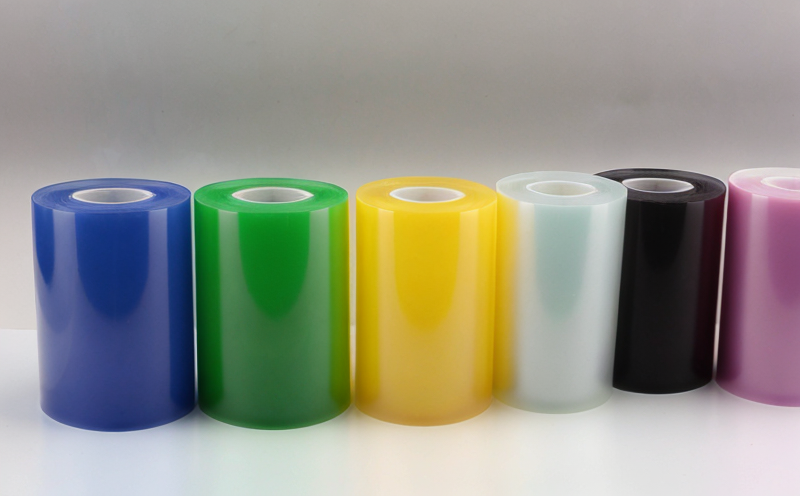ASTM D5116 Indoor Air Emission Testing of Plastic Sheets
The ASTM D5116 standard provides a method to determine the volatile organic compound (VOC) emissions from plastic sheets used in interior environments. This test is critical for ensuring that indoor air quality remains safe and healthy, especially in sectors like residential construction, commercial buildings, and automotive interiors where plastic films and sheets are commonly employed.
Understanding VOCs is essential because they can contribute to the formation of indoor pollutants such as formaldehyde and other harmful chemicals. These compounds can off-gas from materials over time and accumulate indoors if not adequately managed. Proper testing ensures that products meet stringent emission limits, thereby protecting occupant health and well-being.
The ASTM D5116 method involves placing a standard-size sheet of plastic in an environmentally-controlled chamber where it is exposed to ambient air conditions for a specified period. During this time, any volatile organic compounds are released into the chamber's air stream. A sampling port collects these emissions, which are then analyzed using gas chromatography (GC) or similar analytical techniques.
Compliance with ASTM D5116 is particularly important in sectors such as architecture and construction, where materials must meet stringent indoor air quality standards to ensure occupant safety. For R&D engineers and quality managers involved in product development, this test offers a critical tool for ensuring that new formulations or design changes do not inadvertently increase VOC emissions.
For procurement teams, adherence to ASTM D5116 ensures the selection of materials from suppliers who meet rigorous testing protocols. This helps maintain consistency across projects and supports long-term sustainability goals by promoting healthier indoor environments.
In summary, ASTM D5116 is a vital tool for ensuring that plastic sheets used in interior applications do not contribute significantly to harmful VOC emissions. By incorporating this test into your quality control processes, you can help create safer and more sustainable products that meet both regulatory requirements and consumer expectations.
Applied Standards
The ASTM D5116 standard is widely recognized for its accuracy and reliability in measuring indoor air emissions from plastic sheets. It specifies the test method, including specimen preparation, chamber setup, exposure duration, sampling procedures, and analytical techniques.
- ASTM D5116-20: This version of the standard provides detailed instructions for conducting the test, ensuring that all parties involved follow consistent protocols.
- American Society for Testing and Materials (ASTM): As a leading organization in developing standards for materials science, ASTM ensures that D5116 remains relevant and applicable to current industry needs.
The standard is particularly useful for laboratories specializing in environmental testing and quality assurance departments within manufacturing companies. It provides clear guidelines on how to perform the test accurately, ensuring consistent results across different facilities.
For those working with plastic films and sheets, understanding ASTM D5116 helps ensure that products meet strict emission limits set forth by various regulatory bodies. This not only protects end-users but also supports broader sustainability initiatives aimed at reducing environmental impact.
Benefits
- Enhanced Indoor Air Quality: Ensures that products meet strict emission limits, promoting safer environments for occupants.
- Regulatory Compliance: Helps manufacturers adhere to local and international standards regarding indoor air quality.
- Sustainability: Supports broader sustainability goals by minimizing environmental impact through reduced VOC emissions.
- Reputation Enhancement: Demonstrates a commitment to high-quality, environmentally-conscious products, enhancing brand reputation.
- Risk Management: Identifies potential issues early in the product development cycle, mitigating risks associated with non-compliant materials.
- Customer Satisfaction: Ensures that customers receive products they can trust, leading to increased customer satisfaction and loyalty.
In conclusion, ASTM D5116 plays a crucial role in maintaining indoor air quality by providing accurate and reliable methods for measuring VOC emissions from plastic sheets. This service is essential for ensuring compliance with standards and promoting healthier living spaces.
Environmental and Sustainability Contributions
The ASTM D5116 testing method significantly contributes to environmental sustainability by reducing the release of volatile organic compounds into indoor environments. By identifying and controlling VOC emissions, this service helps manufacturers develop products that are not only safe but also environmentally responsible.
Incorporating ASTM D5116 into your quality control processes demonstrates a commitment to sustainable practices. This approach aligns with broader initiatives aimed at reducing the environmental footprint of industries reliant on plastic films and sheets. For R&D engineers, this service offers valuable insights into material performance and potential improvements that can lead to more eco-friendly solutions.
Moreover, compliance with ASTM D5116 supports regulatory requirements set by various bodies around the world. This not only ensures legal adherence but also fosters trust among consumers who are increasingly concerned about environmental impact. By offering this service, we contribute to a healthier planet and inspire confidence in our clients' products.





